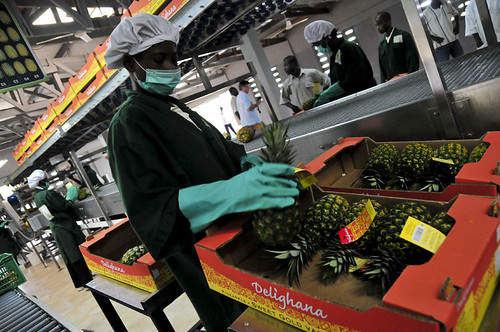 The pineapple sector in Ghana is interesting. Unlike maize, rice, and, to a lesser extent, soyabean, which are all considered staple crops, fruits, including pineapple, mango, and citrus (oranges) are cash crops for which there is an export market. In mango, for example, there are a few companies and independent traders (usually Lebanese) with export markets in the UK, Europe, and the Middle East. More often than not, exporters in the country are either foreigners or Ghanaians who have lived abroad. The reason for this is simple: the person with the most leverage in this industry (aside from the massive retail supermarkets who can literally sink an industry in a matter of years) are those with access to markets. Production is cheap, and production is easy. It is finding someone to buy your products that is the hard part.
The pineapple sector in Ghana is interesting. Unlike maize, rice, and, to a lesser extent, soyabean, which are all considered staple crops, fruits, including pineapple, mango, and citrus (oranges) are cash crops for which there is an export market. In mango, for example, there are a few companies and independent traders (usually Lebanese) with export markets in the UK, Europe, and the Middle East. More often than not, exporters in the country are either foreigners or Ghanaians who have lived abroad. The reason for this is simple: the person with the most leverage in this industry (aside from the massive retail supermarkets who can literally sink an industry in a matter of years) are those with access to markets. Production is cheap, and production is easy. It is finding someone to buy your products that is the hard part.
For the last four decades, agriculture aid in Africa has revolved around training, capacity-building, and mechanization. Bring tractors and train the hell out of the farmer to use them. Give them fertilizer and teach them how to apply it properly. Unfortunately, these approaches rarely take into consideration where all those increased yields are going to be sold. What inevitably happens is that supply grows faster than demand (or at least people/companies who know where demand is and have the money to buy the materials to supply it), which drives the prices down. Rural smallholder farmers tend to be poor and have nonexistent cash flow, so they cannot store their products during the high season and sell for a higher price during the low season. Instead, they have to unload all their product at a lower price, and maybe end up with less money than they had before. The banks who ended up financing all the fertilizer for the production usually end up writing off the loans, because the farmers aren’t making any more profit than they did before. The end result is an agriculture sector that doesn’t work.
The key factor is the market. Continue reading
